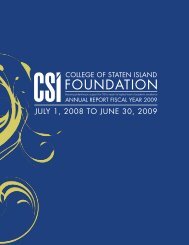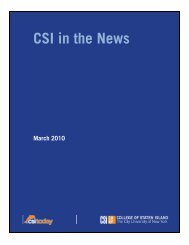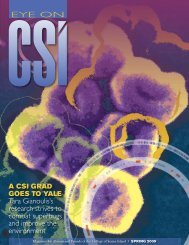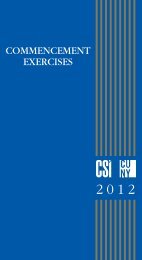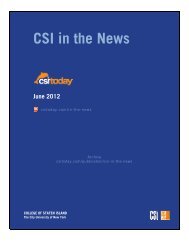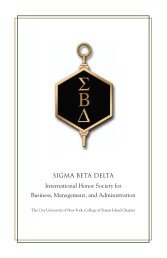csi undergraduate conference on research, scholarship ... - CSI Today
csi undergraduate conference on research, scholarship ... - CSI Today
csi undergraduate conference on research, scholarship ... - CSI Today
Create successful ePaper yourself
Turn your PDF publications into a flip-book with our unique Google optimized e-Paper software.
Research Poster Presentati<strong>on</strong>sP O S T E R 3 9Curcumin and CurcuminDerivatives Affect <strong>on</strong> AmyloidBeta PlaqueRobert TruzzolinoFaculty Mentor: Dr. Alejandra Al<strong>on</strong>soDepartment of BiologyIn Alzheimer disease brain the two most prominentpathological lesi<strong>on</strong>s are the plaques outside theneur<strong>on</strong>s and the tangles inside the neur<strong>on</strong>s. Plaquesare mainly composed of amyloid beta peptide,derived from the amyloid precursor proteins, as a40 and/or 42 amino acid peptide. A great amount ofeffort has been devoted to dissolve the amyloidplaques from Alzheimers disease brains. Moreover,vascular amyloidoses is also a very serious problemfrom the vascular deposits of the amyloid-betapeptide. In this project, we are studying the effectsof curcumin and the glycosilated derivatives indissolving those plaques. The data we obtained isqualitative in the form of pictures obtained using avery powerful microscope known as a transmissi<strong>on</strong>electr<strong>on</strong> microscope and quantitative using aspecific antibody that will detect the differentamounts of the amyloid beta peptide. The resultsobtained remain skeptical with the noti<strong>on</strong> that theglycosilated derivatives of curumin were effectivein dissolving the amyloid-beta plaques. There is agreat potential of this study to be able to generatedrugs applicable to these diseases.P O S T E R 4 0Mercury Assessment in SeafoodPawel PieluszynskiFaculty Mentor: Dr. William WallaceDepartment of BiologyThe main aspect of this <strong>research</strong> is mercurydetecti<strong>on</strong> in aquatic organisms. Mercury is a metalthat was, and still is, widely used in many industrialapplicati<strong>on</strong>s, especially in urban areas such as theNew York Metropolitan area. Fish and shellfishfound in such areas will often c<strong>on</strong>centrate thismetal in their tissues, as mercury is fat soluble.Mercury c<strong>on</strong>centrati<strong>on</strong> is higher in larger fish andpredators, because as these carnivores eat smallerorganisms c<strong>on</strong>taminated with mercury, the metalc<strong>on</strong>centrati<strong>on</strong> accumulates in the bodies of theselarger fish, in a process known as biomagnificati<strong>on</strong>.This can be seen as a major c<strong>on</strong>cern for humanpopulati<strong>on</strong>s, as the c<strong>on</strong>sumpti<strong>on</strong> of suchc<strong>on</strong>taminated fish will increase mercuryc<strong>on</strong>centrati<strong>on</strong> in human tissues, which can cause aplethora of health problems. Therefore, it isextremely important to m<strong>on</strong>itor mercuryc<strong>on</strong>centrati<strong>on</strong>s in aquatic life, especially the speciesthat are most harvested and c<strong>on</strong>sumed by humans.In this project, the tissues of various aquatic speciesthat are of culinary value will be tested for theirc<strong>on</strong>centrati<strong>on</strong> of mercury using a FIMSspectrometer. Some of these aquatic animals will belocal species, while others will be n<strong>on</strong>-local, whichcan be bought in a supermarket. This will be d<strong>on</strong>eto determine whether local seafood c<strong>on</strong>tains lessmercury and is safer to eat than imported seafood,or if the opposite is true.45



